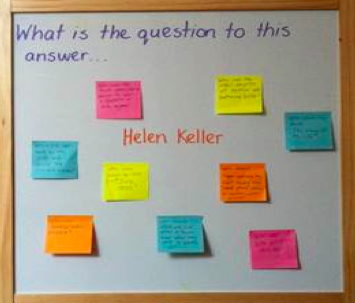Google Apps has its own unique quirks that can make life more efficient. Here are 10 tips EVERY teacher should know. (Flickr / Chris Schrier)
- Ctrl+C = Copy
- Ctrl+V = Paste
- Ctrl+Z = Undo
- Hold in Ctrl and use the arrow keys to jump from word to word or paragraph to paragraph
- Hold in Shift and use the arrow keys to highlight text
(If you didn’t know those already, you may have just gotten your best takeaway points from this blog post in the second paragraph!)
Since Google Apps has come on the scene and taken the education world by storm, there are some quirks … no, eccentricities … no, subtleties … yes, subtleties! that come with the territory.
If you know them, you’re probably more efficient and quicker than you were before them. If you don’t know them, well, your mind might be blown just a little bit after reading this post.
Here are 10 great Google Apps tips that EVERY teacher should know. (Note: Throughout this post, Ctrl can be substituted with Command on Mac computers.)
1. The power of searching – Need to fish a file out of your Google Drive? Searching can be so much faster than clicking through folders. I timed myself once. It took me 15 seconds to find a file in my complex folder system and only 6 seconds by using the search bar at the top of my Drive. I’ve largely quit filing files in folders in Google Drive for this reason. (Certainly it’s not laziness, right???)
2. Save that tab – Ever closed a tab and thought (or said out loud) (or screamed!), “Oh no, why did I close that? Noooo!” If Google Chrome or Firefox is your web browser of choice, it can save your bacon. Simply press Ctrl+Shift+T (undo close tab) and it appears out of thin air. It even saves your browsing history, meaning you can still hit the “back” key to go back.
3. Revision history – It happens to the best of us. A student types something inappropriate on a shared document. Or we wipe out large parts of a very important slide presentation. Never fear … revision history is here! Find it under the File menu (or contort your fingers to use the Ctrl+Alt+Shift+G hotkey). It will show you who made changes throughout the life of the file and let you restore a previous version.
Google Apps isn’t just Docs, Slides and Sheets! Find more apps by clicking “More” at the bottom of the “New” menu. Add more apps by clicking “Connect more apps”. Here’s what my apps menu looks like.
4. More than Docs, Slides and Sheets – We often think Google Apps is synonymous with the basic elements of Microsoft Office — Docs for Word, Slides for PowerPoint, Sheets for Excel. Not so! Click the red “New” button and then click “More” at the bottom of the menu. You’ll see new apps, including Google Forms (for surveys), Google Drawings (a simple graphic design app) and Google MyMaps (for creating custom maps with pins). Add others with “Connect more apps” at the bottom.
5. Add-ons – In the same vein as the additional Google apps, add-ons let you unlock new functions within individual files. Once you have a document, slide presentation or spreadsheet open, click the “Add-ons” menu. You’ll be able to add plenty of add-ons (see some in this post about add-ons). They include Flubaroo, a popular one that auto-grades quizzes and tests created in Google Forms.
6. Modify your URLs – URLs (also called “links” or “web addresses,” among others) are a key part of sharing files in Google Apps. Often, they start with “docs.google.com” and end with the word “edit”. Here’s a pro tip — by changing that word “edit,” you can make the file load differently. Examples: If you change “edit” to …
- “Copy” — It will force the person loading the file to make a copy of that file to his/her Google Drive.
- “Preview” — It will show a non-editable version of the file (a read-only version).
Give it a try to see how it works, and then start using it as a weapon of mass awesomeness!
7. Handy animals – Ever notice those colorful icons that appear at the top of a Google file when others are using the file too? Those aren’t just decorations, and they aren’t ONLY there to show who’s also viewing the file. You can quickly jump to where anyone is editing the file to see what he/she is doing by clicking on his/her colored icon. This is nice when working with a large file.
8. Table of contents – Speaking of large files (documents, specifically), one way to make them more manageable is to organize them with a table of contents. This creates a clickable list of the sections of the file that lets you jump to any part of the file you desire. It’s really easy to create them! Just …
- Type in some sort of section header above the different sections of the document you want to create. (It can be as simple as “Section 1″, “Section 2″, etc.)
- Highlight those section headers and click the dropdown at the top that says “Normal text”. Choose “Heading 1″.
- Click “Insert > Table of contents”.
Once the table of contents is there, you can even modify the text in it so it looks exactly as you’d like.
9. Image search – Want to help students be good digital citizens while they create gorgeous Google Apps files for you? Of course you do! But standard Google Images searches often display copyrighted images that students don’t have permission to use. Thankfully, Google has integrated a more responsible search tool into its apps. Click the image button up above the file you’re working on (or click “Insert > Image …”). Then choose “Search” out of the tabs at the top. This search displays Creative Commons images that are labeled for commercial reuse with modification — the most permissive Creative Commons license. (Want to know what Creative Commons images are OR how to use them the right way? Check out this post.)
10. Voice typing – This is a newer feature that might just blow your mind. Go to “Tools > Voice typing …” and click on the microphone icon that appears. Google Apps uses the microphone in your device to type the words you speak. This is great if you’re a very verbal person and would prefer to talk instead of type. It’s also great for students who may struggle using a standard keyboard. I’ve used it and it’s pretty accurate!









 Computer Science & Google, all together- Now you can see Google’s tools and programs for computer science education all in one place.
Computer Science & Google, all together- Now you can see Google’s tools and programs for computer science education all in one place.  Let your voice do the heavy lifting- Google Docs gets an upgrade with
Let your voice do the heavy lifting- Google Docs gets an upgrade with 

 Easy charts & insights-
Easy charts & insights- 


